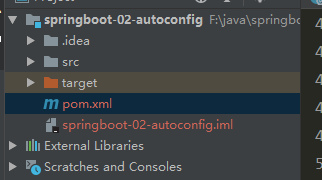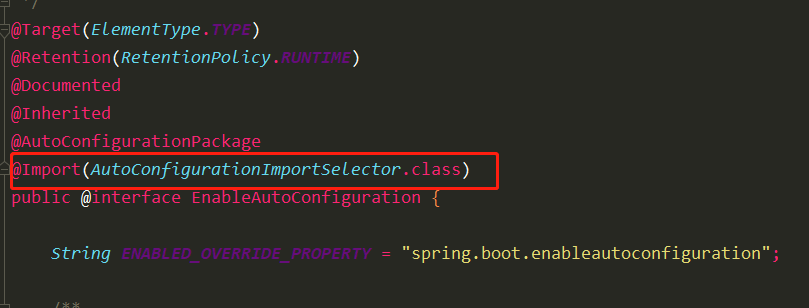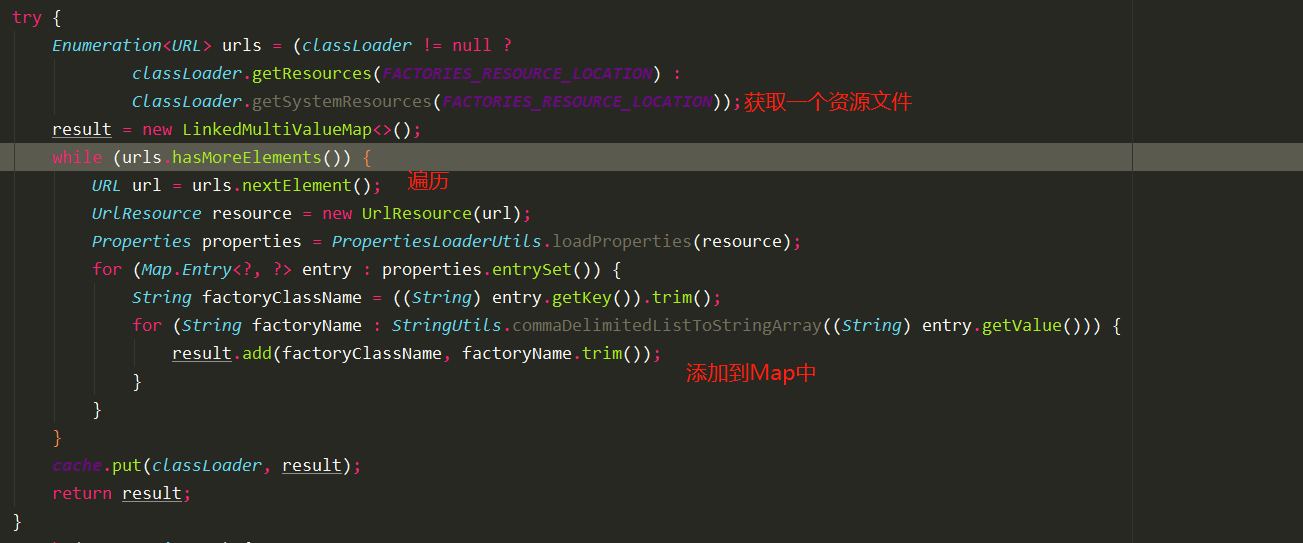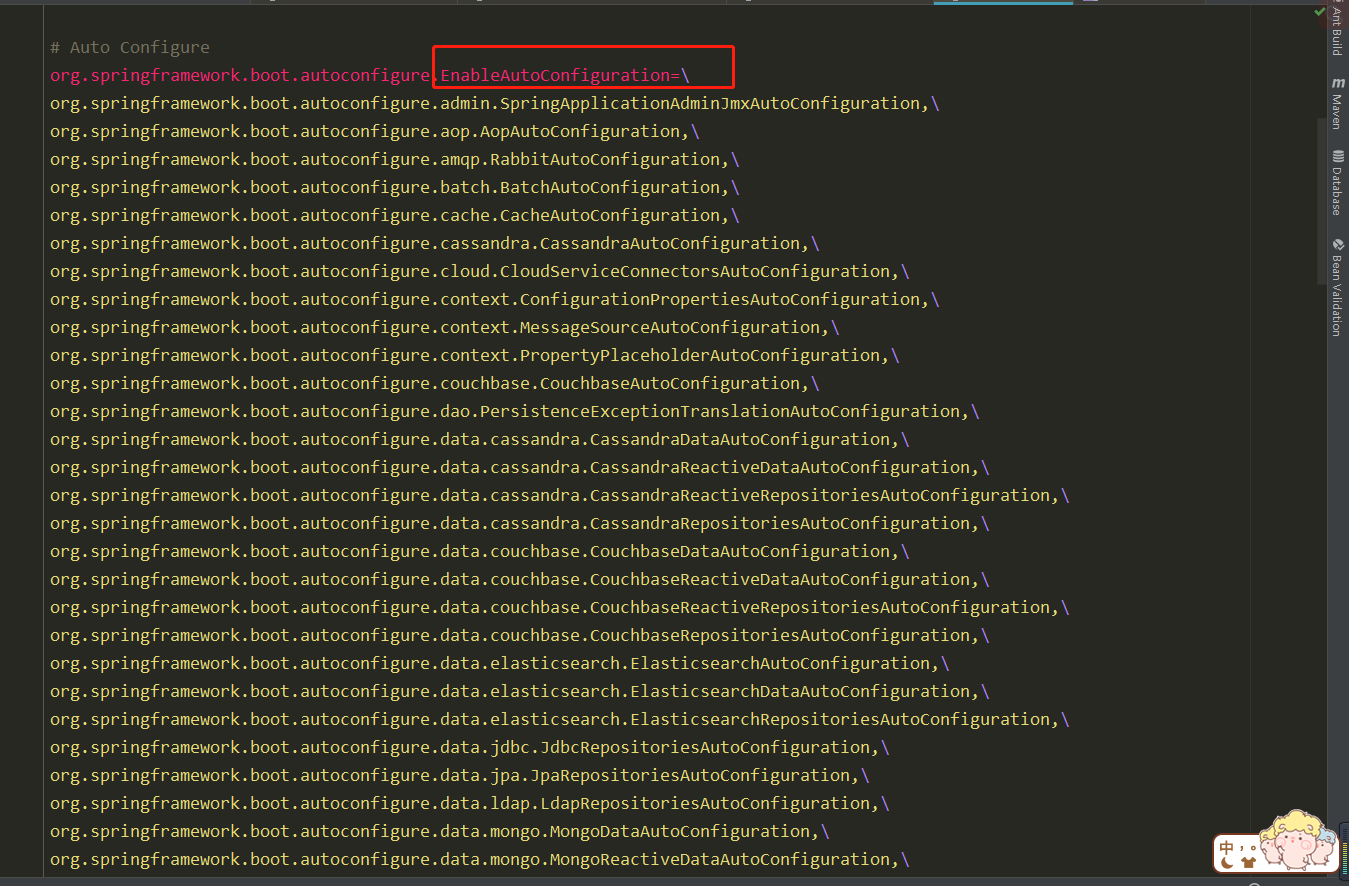SpringBoot配置 SpringBoot是Spring系列的延伸,Spring需要自己去配置各种属性。SpringBoot 的出现就是为了简化程序员的配置工作,所谓“约定大于配置”。 所以,自动配置 是SpringBoot的核心。
SpringBoot能配置什么呢?
查看文档common-application-properties .
创建SpringBoot项目 项目目录结构:
自动配置原理 首先我们知道SpringBoot有一个启动类,其实也是一个配置类,其有main方法,可以直接运行。使用@SpingBootApplication注解表示它是一个配置类。
@SpringBootApplication : Spring Boot应用标注在某个类上说明这个类是SpringBoot的主配置类,SpringBoot就应该运行这个类的main方法来启动SpringBoot应用;
1 2 3 4 5 6 7 8 9 10 11 package com.hongliang.springboot;import org.springframework.boot.SpringApplication;import org.springframework.boot.autoconfigure.SpringBootApplication;@SpringBootApplication public class Springboot02AutoconfigApplication public static void main (String[] args) SpringApplication.run(Springboot02AutoconfigApplication.class, args); } }
我们点击进去这个注解:
1 2 3 4 5 6 7 8 @Retention(RetentionPolicy.RUNTIME) @Documented @Inherited @SpringBootConfiguration @EnableAutoConfiguration @ComponentScan(excludeFilters = { @Filter(type = FilterType.CUSTOM, classes = TypeExcludeFilter.class), @Filter(type = FilterType.CUSTOM, classes = AutoConfigurationExcludeFilter.class) }) public @interface SpringBootApplication {
我们可以看到有一个@EnableAutoConfiguration的注解,这个注解的作用就是开启自动配置功能。
发现里面有一个@Import(AutoConfigurationImportSelector.class), 作用是给容器中带入一些组件,那么具体导入那些组件呢?我们继续查看AutoConfigurationImportSelector这个类。
1 2 3 4 5 6 7 8 9 10 11 12 13 14 15 16 17 18 19 20 21 22 23 24 25 26 27 28 29 30 31 32 33 34 public class AutoConfigurationImportSelector implements DeferredImportSelector , BeanClassLoaderAware , ResourceLoaderAware , BeanFactoryAware , EnvironmentAware , Ordered { private static final AutoConfigurationEntry EMPTY_ENTRY = new AutoConfigurationEntry(); @Override public String[] selectImports(AnnotationMetadata annotationMetadata) { if (!isEnabled(annotationMetadata)) { return NO_IMPORTS; } AutoConfigurationMetadata autoConfigurationMetadata = AutoConfigurationMetadataLoader .loadMetadata(this .beanClassLoader); AutoConfigurationEntry autoConfigurationEntry = getAutoConfigurationEntry(autoConfigurationMetadata, annotationMetadata); return StringUtils.toStringArray(autoConfigurationEntry.getConfigurations()); } protected AutoConfigurationEntry getAutoConfigurationEntry (AutoConfigurationMetadata autoConfigurationMetadata, AnnotationMetadata annotationMetadata) if (!isEnabled(annotationMetadata)) { return EMPTY_ENTRY; } AnnotationAttributes attributes = getAttributes(annotationMetadata); List<String> configurations = getCandidateConfigurations(annotationMetadata, attributes); configurations = removeDuplicates(configurations); Set<String> exclusions = getExclusions(annotationMetadata, attributes); checkExcludedClasses(configurations, exclusions); configurations.removeAll(exclusions); configurations = filter(configurations, autoConfigurationMetadata); fireAutoConfigurationImportEvents(configurations, exclusions); return new AutoConfigurationEntry(configurations, exclusions); } }
selectImports方法选择组件进行导入,里面调用了getAutoConfigurationEntry方法来获取哪些配置,返回的是一个AutoConfigurationEntry类, 之后转成一个字符串数组
1 2 3 4 5 6 7 8 9 10 11 12 13 14 15 16 17 18 19 20 21 22 23 24 protected static class AutoConfigurationEntry private final List<String> configurations; private final Set<String> exclusions; private AutoConfigurationEntry () this .configurations = Collections.emptyList(); this .exclusions = Collections.emptySet(); } AutoConfigurationEntry(Collection<String> configurations, Collection<String> exclusions) { this .configurations = new ArrayList<>(configurations); this .exclusions = new HashSet<>(exclusions); } public List<String> getConfigurations () return this .configurations; } public Set<String> getExclusions () return this .exclusions; } }
我们再来看一下getAutoConfigurationEntry这个方法的具体操作:在AutoConfigurationImportSelector这个类里面
1 2 3 4 5 6 7 8 9 10 11 12 13 14 15 protected AutoConfigurationEntry getAutoConfigurationEntry (AutoConfigurationMetadata autoConfigurationMetadata, AnnotationMetadata annotationMetadata) if (!isEnabled(annotationMetadata)) { return EMPTY_ENTRY; } AnnotationAttributes attributes = getAttributes(annotationMetadata); List<String> configurations = getCandidateConfigurations(annotationMetadata, attributes); configurations = removeDuplicates(configurations); Set<String> exclusions = getExclusions(annotationMetadata, attributes); checkExcludedClasses(configurations, exclusions); configurations.removeAll(exclusions); configurations = filter(configurations, autoConfigurationMetadata); fireAutoConfigurationImportEvents(configurations, exclusions); return new AutoConfigurationEntry(configurations, exclusions); }
这个方法首先调用了getCandidateConfigurations获取候选配置,返回的是一个List集合,然后封装成AutoConfigurationEntry返回。
所以我们还需要看一下getCandidateConfigurations干了啥:
1 2 3 4 5 6 7 8 9 10 11 protected List<String> getCandidateConfigurations (AnnotationMetadata metadata, AnnotationAttributes attributes) List<String> configurations = SpringFactoriesLoader.loadFactoryNames(getSpringFactoriesLoaderFactoryClass(), getBeanClassLoader()); Assert.notEmpty(configurations, "No auto configuration classes found in META-INF/spring.factories. If you " + "are using a custom packaging, make sure that file is correct." ); return configurations; } protected Class<?> getSpringFactoriesLoaderFactoryClass() { return EnableAutoConfiguration.class; }
首先调用SpringFactoriesLoader.loadFactoryNames(Class<?> factoryClass, @Nullable ClassLoader classLoader)里面传入需要返回哪个自动配置类,这里调用了getSpringFactoriesLoaderFactoryClass, 返回的是EnableAutoConfiguration.class。
再看看SpringFactoriesLoader.loadFactoryName() 的具体细节:这个方法在SpringFactoriesLoader这个类里面,
1 2 3 4 5 6 7 8 9 10 11 12 13 14 15 16 17 18 19 20 21 22 23 24 25 26 27 28 29 30 31 32 33 34 35 36 public static final String FACTORIES_RESOURCE_LOCATION = "META-INF/spring.factories" ; public static List<String> loadFactoryNames (Class<?> factoryClass, @Nullable ClassLoader classLoader) String factoryClassName = factoryClass.getName(); return loadSpringFactories(classLoader).getOrDefault(factoryClassName, Collections.emptyList()); } private static Map<String, List<String>> loadSpringFactories(@Nullable ClassLoader classLoader) { MultiValueMap<String, String> result = cache.get(classLoader); if (result != null ) { return result; } try { Enumeration<URL> urls = (classLoader != null ? classLoader.getResources(FACTORIES_RESOURCE_LOCATION) : ClassLoader.getSystemResources(FACTORIES_RESOURCE_LOCATION)); result = new LinkedMultiValueMap<>(); while (urls.hasMoreElements()) { URL url = urls.nextElement(); UrlResource resource = new UrlResource(url); Properties properties = PropertiesLoaderUtils.loadProperties(resource); for (Map.Entry<?, ?> entry : properties.entrySet()) { String factoryClassName = ((String) entry.getKey()).trim(); for (String factoryName : StringUtils.commaDelimitedListToStringArray((String) entry.getValue())) { result.add(factoryClassName, factoryName.trim()); } } } cache.put(classLoader, result); return result; } catch (IOException ex) { throw new IllegalArgumentException("Unable to load factories from location [" + FACTORIES_RESOURCE_LOCATION + "]" , ex); } }
主要看这一段
首先会去加载一个配置文件,这个配置文件在类的开头声明了一个静态的常量:
1 public static final String FACTORIES_RESOURCE_LOCATION = "META-INF/spring.factories" ;
看一下这个配置文件是什么内容:
看到这里应该对大致的流程有一个清晰的了解了,SpringFactoriesLoader.loadFactoryNames()扫描所有jar包类路径下 META-INF/spring.factories. 把扫描到的这些文件的内容包装成properties对象properties中获取到EnableAutoConfiguration.class类(类名)对应的值,然后把他们添加在容器中,这些值就是上图中黄色字体部分的XXXAutoConfiguration。每一个自动配置类XXXAutoConfiguration 都是都是容器中的一个组件,都加入到容器中;用他们来做自动配置;
然后每一个自动配置类进行自动配置功能。
HttpEncodingAutoConfiguration 以HttpEncodingAutoConfiguration为例解释自动配置原理
1 2 3 4 5 6 7 8 9 10 11 12 13 14 15 16 17 18 19 20 21 22 23 24 25 26 27 28 29 30 31 32 33 @Configuration @EnableConfigurationProperties(HttpProperties.class) @ConditionalOnWebApplication(type = ConditionalOnWebApplication.Type.SERVLET) @ConditionalOnClass(CharacterEncodingFilter.class) @ConditionalOnProperty(prefix = "spring.http.encoding", value = "enabled", matchIfMissing = true) public class HttpEncodingAutoConfiguration private final HttpProperties.Encoding properties; public HttpEncodingAutoConfiguration (HttpProperties properties) this .properties = properties.getEncoding(); } @Bean @ConditionalOnMissingBean public CharacterEncodingFilter characterEncodingFilter () CharacterEncodingFilter filter = new OrderedCharacterEncodingFilter(); filter.setEncoding(this .properties.getCharset().name()); filter.setForceRequestEncoding(this .properties.shouldForce(Type.REQUEST)); filter.setForceResponseEncoding(this .properties.shouldForce(Type.RESPONSE)); return filter; } }
可以看上面详细的注释理解每个注解的功能。
根据当前不同的条件判断,决定这个配置类是否生效?
一但这个配置类生效;这个配置类就会给容器中添加各种组件;这些组件的属性是从对应的properties类中获取的,这些类里面的每一个属性又是和配置文件绑定的;
我们看一下properties类中内容:
1 2 3 4 5 6 7 8 9 10 11 12 13 14 15 16 17 18 19 20 21 22 23 24 25 26 27 28 29 30 31 32 33 34 35 36 37 38 39 40 41 42 43 44 45 46 47 48 49 50 51 52 53 54 55 56 57 58 59 60 61 62 63 64 65 66 67 68 69 70 71 72 73 74 75 76 77 78 79 80 81 82 83 84 85 86 87 88 89 90 91 92 93 94 95 96 97 98 99 100 101 102 103 104 105 106 107 108 109 110 111 112 113 114 115 116 117 118 119 120 121 122 @ConfigurationProperties(prefix = "spring.http") public class HttpProperties private boolean logRequestDetails; private final Encoding encoding = new Encoding(); public boolean isLogRequestDetails () return this .logRequestDetails; } public void setLogRequestDetails (boolean logRequestDetails) this .logRequestDetails = logRequestDetails; } public Encoding getEncoding () return this .encoding; } public static class Encoding public static final Charset DEFAULT_CHARSET = StandardCharsets.UTF_8; private Charset charset = DEFAULT_CHARSET; private Boolean force; private Boolean forceRequest; private Boolean forceResponse; private Map<Locale, Charset> mapping; public Charset getCharset () return this .charset; } public void setCharset (Charset charset) this .charset = charset; } public boolean isForce () return Boolean.TRUE.equals(this .force); } public void setForce (boolean force) this .force = force; } public boolean isForceRequest () return Boolean.TRUE.equals(this .forceRequest); } public void setForceRequest (boolean forceRequest) this .forceRequest = forceRequest; } public boolean isForceResponse () return Boolean.TRUE.equals(this .forceResponse); } public void setForceResponse (boolean forceResponse) this .forceResponse = forceResponse; } public Map<Locale, Charset> getMapping () return this .mapping; } public void setMapping (Map<Locale, Charset> mapping) this .mapping = mapping; } public boolean shouldForce (Type type) Boolean force = (type != Type.REQUEST) ? this .forceResponse : this .forceRequest; if (force == null ) { force = this .force; } if (force == null ) { force = (type == Type.REQUEST); } return force; } public enum Type REQUEST, RESPONSE } } }
里面包括了可以配置的所有属性。
所有在配置文件中能配置的属性都是封装在xxxxProperties类中,配置文件能配置什么就可以参照某个功能对应的这个属性类。
@Conditional派生注解 作用:必须是@Conditional指定的条件成立,才给容器中添加组件,配置配里面的所有内容才生效;
@Conditional扩展注解 作用(判断是否满足当前指定条件) @ConditionalOnJava 系统的java版本是否符合要求 @ConditionalOnBean 容器中存在指定Bean; @ConditionalOnMissingBean 容器中不存在指定Bean; @ConditionalOnExpression 满足SpEL表达式指定 @ConditionalOnClass 系统中有指定的类 @ConditionalOnMissingClass 系统中没有指定的类 @ConditionalOnSingleCandidate 容器中只有一个指定的Bean,或者这个Bean是首选Bean @ConditionalOnProperty 系统中指定的属性是否有指定的值 @ConditionalOnResource 类路径下是否存在指定资源文件 @ConditionalOnWebApplication 当前是web环境 @ConditionalOnNotWebApplication 当前不是web环境 @ConditionalOnJndi JNDI存在指定项
自动配置类必须在一定的条件下才能生效;
我们怎么知道哪些自动配置类生效;
**==我们可以通过启用 debug=true属性;来让控制台打印自动配置报告==**,这样我们就可以很方便的知道哪些自动配置类生效;
总结 1)、SpringBoot启动会加载大量的自动配置类
2)、我们看我们需要的功能有没有SpringBoot默认写好的自动配置类;
3)、我们再来看这个自动配置类中到底配置了哪些组件;(只要我们要用的组件有,我们就不需要再来配置了)
4)、给容器中自动配置类添加组件的时候,会从properties类中获取某些属性。我们就可以在配置文件中指定这些属性的值;
xxxxAutoConfigurartion:自动配置类;
给容器中添加组件
xxxxProperties:封装配置文件中相关属性;
spring Boot启动的时候会通过@EnableAutoConfiguration注解找到META-INF/spring.factories配置文件中的所有自动配置类,并对其进行加载,而这些自动配置类都是以AutoConfiguration结尾来命名的,它实际上就是一个JavaConfig形式的Spring容器配置类,它能通过以Properties结尾命名的类中取得在全局配置文件中配置的属性如:server.port,而XxxxProperties类是通过@ConfigurationProperties注解与全局配置文件中对应的属性进行绑定的。










